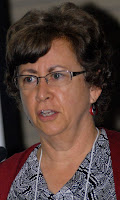
BREAKING NEWS
Quarantine Imminent For ACP Finds
By Patrick Cavanaugh
Edited By Laurie Greene
 |
| Concerned Growers Listen intently for further Instructions. |
Nearly 300 growers, PCAs and others with an interest in the California citrus industry gathered at the Heritage Complex Auditorium in Tulare today as nearly 178 square miles, representing 21,520 acres of citrus, sits waiting for the establishment of a quarantine following the trapping of six Asian Citrus Psyllids (ACPs) in mid June in Porterville.
There was apprehension and somber anticipation in the audience as the industry prepares for the largest quarantined area to be established in the San Joaquin Valley citrus orchards, where 10,800 jobs are directly related to citrus.
Citrus is a $2 billion industry in California, with about 80 percent of the entire California Citrus industry in the San Joaquin Valley. In Tulare County alone, the citrus industry is valued at $768 million on 119,000 acres.
This meeting was one of the most important meetings ever held in Tulare County regarding the ACP, which spreads Huanglongbing (HLB).
 |
| Marilyn Kinoshita |
Marilyn Kinoshita, Tulare County Agricultural Commissioner, assured those in attendance that the quarantine is still pending as of July 30, but it will be imposed and remain in place until two complete, pest-free years elapse. In other words, if another psyllid is trapped in August, the two years will start again.
 |
| Victoria Hornbaker |
Victoria Hornbaker, program manager, CDFA/Citrus Pest & Disease Prevention Committee presented a history of on ACP and HLB stating that it was first detected in Florida in 1998 and California in 2008. She explained that the invasive pest can spread HLB which is deadly to citrus trees and incurable.
“Our citrus pest and disease prevention program consists of detection, trapping, visual survey, delimitation trapping, treatment and quarantines,” Hornbaker said.
Hornbaker noted that the pending state and federal quarantine will affect growers, packing houses, haulers and others within five miles around the recent ACP finds in the Porterville area. He said the quarantine will be established to prevent the spread of ACPs within the quarantine area and from known infested (quarantined) areas to outside the Quarantine area, i.e., the rest of the state and beyond.
Nawal Sharma, CDFA Environmental Program Manager, presented more details about the upcoming quarantine.
“If you are outside the five mile area, you do not need to do anything different, as the regulations do not apply to you,” Sharma said.
 |
| Nawal Sharm |
“We have identified about 11 packing houses within the five-mile area. This does not mean, ‘Stop your business.’ If you are a grower within the quarantine area and are shipping to one of the packinghouses within the quarantine area, there is absolutely no impact on you. The reason is that the regulations allow moving the fruit along with leaves and stems within the quarantine area.”
“Now if a grower inside the quarantine area intends to ship to packinghouse outside the quarantine area he must make certain that all fruit is free of stems and leaves,” said Sharma. “The fruit then must be cleaned with a particular machine with rollers before it can leave a quarantine area.”
Transporters of fruit from a quarantine area to packinghouses outside the quarantine area must be in compliance, as are the growers.
 |
| Beth Grafton-Cardwell |
Beth Grafton-Cardwell, IPM Specialist and Research Entomologist, Department of Entomology, UC Riverside, spoke about the psyllid treatment options in the quarantine area.
She instructed that it is important to stay proactive with effective insecticide treatments within the quarantine area. “Apply two ACP-effective materials with different modes of action as soon as possible after ACP detection, starting with one from the broad spectrum group,” Grafton-Cardwell explained. “The best treatment combination is a foliar pyrethroid (Baythroid, Danitol, Tombstone, or Mustang), plus a systemic neonicotinoid (Admire Pro or generic imidacloprid, or Platinum).
“Apply the foliar first for rapid knockdown and the systemic close to the same time since it takes time for uptake into the tree,” said Grafton-Cardwell.
“Use a systemic only if it will be effective with a proper irrigation system, soil type and appropriate timing for good uptake (June-October),” she said.
She noted that growers should be vigilant in scouting trees for ACP. She said the current protocol is to sample 10 trees each on the north, east, south and west borders of the orchard, plus in the center for a total of 50 trees. “The psyllid prefers borders and so the focus is on the outside edges of orchards,” she said.
Grafton-Cardwell described the Tap Sampling, Visual Sampling and Flush Sampling methods.
She shared a new website http://www.ucanr.edu/sites/acp that will explain all control protocols including details on management strategies, sampling, chemical control and sample costs for the growers’ budget.
 |
| Ken Keck |
Finally, Ken Keck, president of the California Citrus Research Board (CRB), made a sobering point to growers. Keck is the former executive director of the Florida Department of Citrus and a current citrus grower in Florida. “My grove is heavily infected with HLB. I feel like the ex-con in front of a room with 17-year olds. So don’t make the mistakes that we made in Florida. You know the Florida and Texas experience, so the stage that the Central Valley is in right now is to Prevent, Prevent, Prevent.”
“It would be a tremendous mistake if the experiences of Texas and Florida did not help increase California’s motivation to deal with this pest and hopefully never [have to deal with] the disease,” Keck said.
“We all need to take this very seriously and stay on the prevention programs. We need all boots on the ground to get after this problem,” stated Keck. “There is hope that we can keep HLB from infecting commercial orchards in California because of the grower’s quick and united action,” Keck said.








